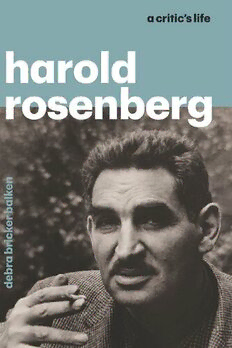
Harold Rosenberg: A Critic‘s Life PDF
Preview Harold Rosenberg: A Critic‘s Life
harold rosenberg harold rosenberg a critic’s life n o d n o L d n a o g a c hi C s s e r P o g a c i h C f o y t i s r e v i n U debra bricker balken e h T The University of Chicago Press, Chicago 60637 The University of Chicago Press, Ltd., London © 2021 by The University of Chicago All rights reserved. No part of this book may be used or reproduced in any manner whatsoever without written permission, except in the case of brief quotations in critical articles and reviews. For more information, contact the Uni- versity of Chicago Press, 1427 E. 60th St., Chicago, IL 60637. Published 2021 Printed in the United States of America 30 29 28 27 26 25 24 23 22 21 1 2 3 4 5 ISBN- 13: 978- 0- 226- 03619- 9 (cloth) ISBN- 13: 978- 0- 226- 74020- 1 (e- book) DOI: https:// doi .org /10 .7208 /chicago /9780226740201 .0001 Library of Congress Cataloging- in- Publication Data Names: Balken, Debra Bricker, author. Title: Harold Rosenberg : a critic’s life / Debra Bricker Balken. Description: Chicago : University of Chicago Press, 2021. | Includes bibliographical references and index. Identifiers: LCCN 2021012758 | ISBN 9780226036199 (cloth) | ISBN 9780226740201 (ebook) Subjects: LCSH: Rosenberg, Harold, 1906–1978. | Art critics—United States—Biography. Classification: LCC N7483.R655 B355 2021 | DDC 709.2 [B]— dc23 LC record available at https:// lccn .loc .gov /2021012758 ♾ This paper meets the requirements of ANSI/NISO Z39.48- 1992 (Permanence of Paper). to the memory of Scott Kerr Bricker Sr. and Arthur C. Danto contents Prologue ix 1 never had any dreams: borough park 1 2 in the landscape of sensibility: east houston street 15 3 a capacity for action: poetry: a magazine of verse and the new act 26 4 we write for the working class: the american writers’ congress 51 5 you would have to be recluse to stay out of it: art front 76 6 american stuff 99 7 myth and history: partisan review 115 8 partisans and politics 131 9 a totally different america: washington, dc 150 10 the profession of poetry: trance above the streets 180 11 death in the wilderness: the OWI and the american ad council 199 12 notes on identity: VVV and view 215 13 possibilities 237 14 les temps modernes 256 15 an explanation to the french of what was cooking: “the american action painters” 268 16 guilt to the vanishing point: commentary magazine 288 17 a triangle of allegiances: arendt and mccarthy 307 18 the tradition of the new 326 19 pop culture and kitsch criticism 341 20 play acting: arshile gorky 357 21 problems in art criticism: artforum 371 22 location magazine and the long view 393 23 the new yorker 412 24 the professor of social thought 452 Acknowledgments 479 Notes 485 Bibliography 587 Illustration Credits 607 Index 609 prologue Harold Rosenberg always resisted the in- crowd. From the moment he entered Erasmus Hall in 1919, an elite high school in Brooklyn, he felt ostracized by the rivaling cliques of students who dominated the social scene. Many came from rich families— Jewish and non- Jewish alike— but he found no common ground with even the few freshmen who lived in his own dreary neighborhood of Borough Park. His father, while intellectually inclined, was a lower middle- class tailor who had moved the family from Harlem when Harold was eight to settle in a Jewish community where the way of life was decidedly conformist. Religion became anathema to Rosenberg— he hated the long, ritualized Saturday services— along with his fa- ther’s bourgeois aspirations. By the time he attended Erasmus Hall, his anti- authoritarian streak was intact. The only place he felt at home was on the baseball field or when rowing on the lake in Pros- pect Park. To compound his sense of difference, Rosenberg grew to be 6 feet, 4 inches tall. By the time he was an adolescent, he towered not only over his family but also over his teachers and fellow students. With his radiant dark eyes capped by black, bushy brows and a prominent forehead, he came across as a colossus, a sort of oddity (fig. 1). To add to his eccentricity, his high- pitched, nasal voice always seemed out of sync with his height. He lumbered through the corridors of Erasmus Hall, where he became more and more introverted and had little interaction with his classmates. As a result, studying be- came his primary outlet. In today’s terms, he was a nerd. But once
